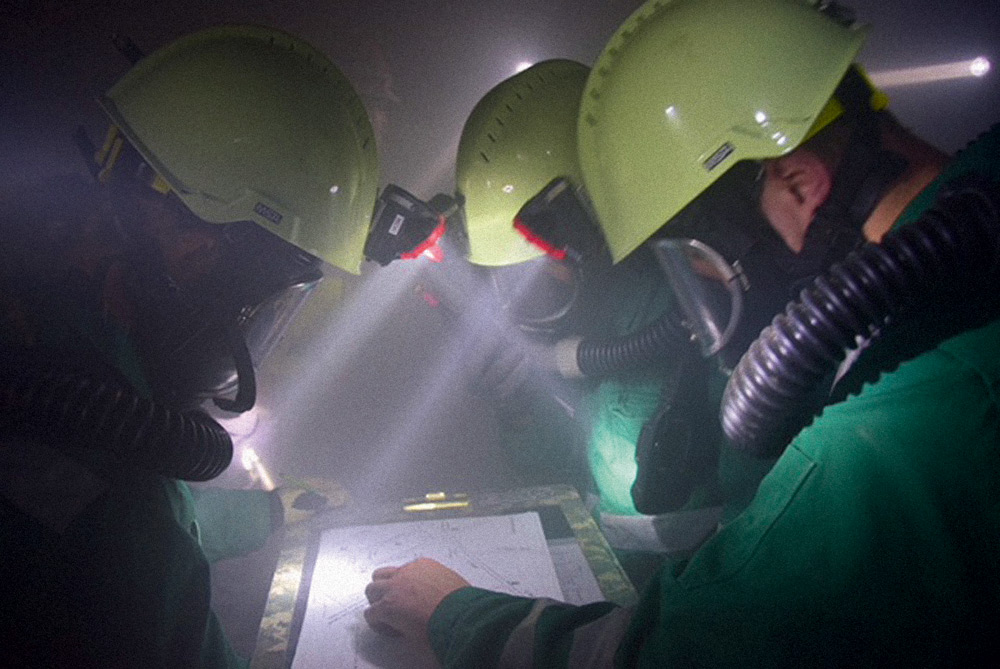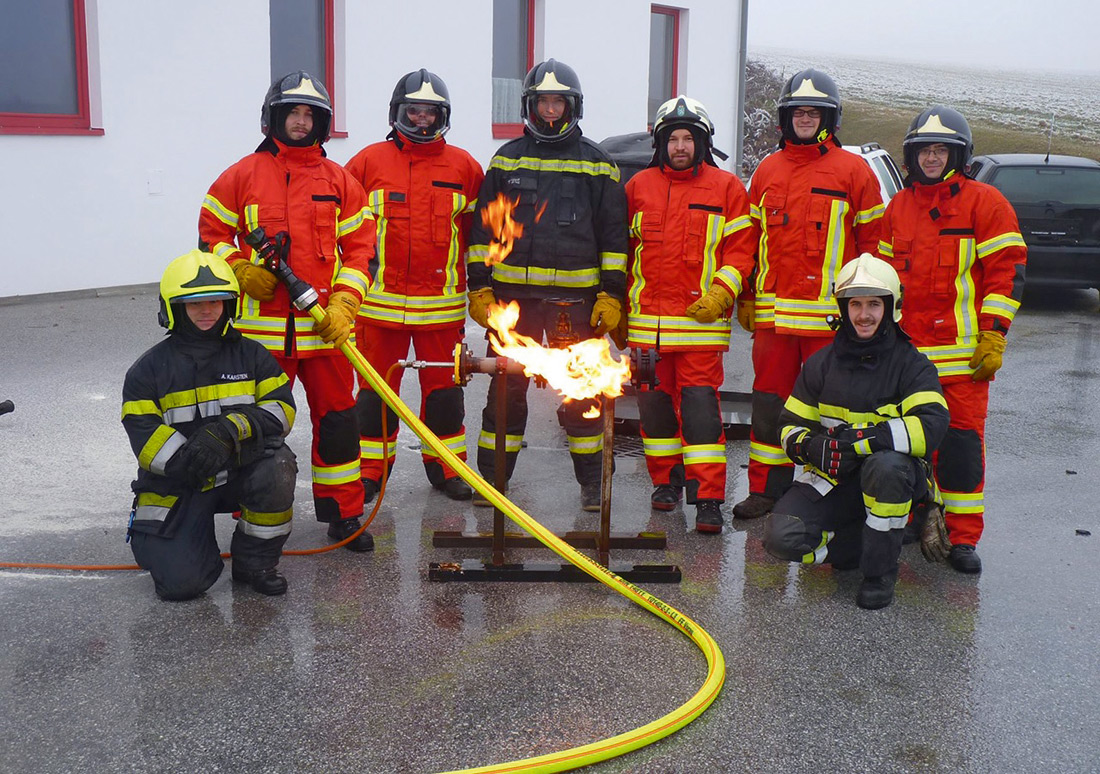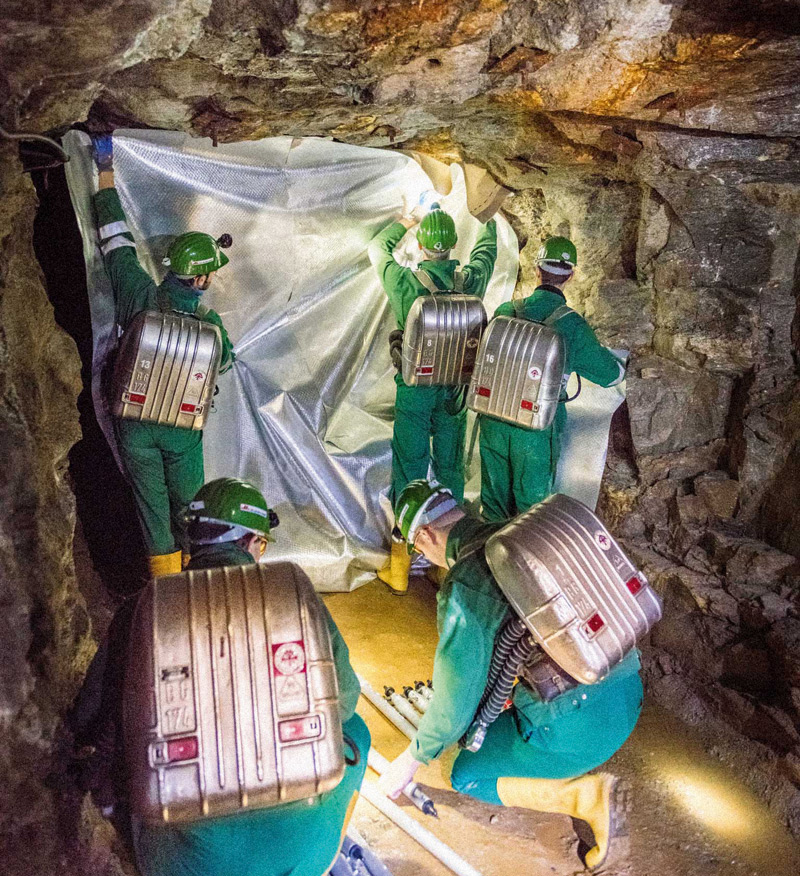In the context of the constant expansion of the Research and Educational Mine of the Technical University (TU) Bergakademie Frei-berg/Germany, and the structural change of the Central German mining industry, new adjustments need to be made on the local mine rescue organization. This article examines the structure of the mine rescue organization at TU Bergakademie Freiberg. Parallel to this restructuring, the Chair of Underground Mining Methods of the Institute for Mining and Special Civil Engineering at TU Bergakademie Freiberg has established an extended training programme in incident management and mine rescue. The article gives an insight into the training contents and forms. The aim of this training programme is to provide the mining industry with graduates who have the training level of underground mine rescue aspirants and who, as future managers, will also have knowledge in the field of emergency response and crisis management.
Besides TU Bergakademie Freiberg, the Montanuniversität Leoben in Austria has also established a student training programme in the field of emergency response and rescue deployment. Within the framework of university cooperation, the European training project MINERS is in its start-up phase at the time of the writing of this article. In addition to the Montanuniversität Leoben, which is responsible for coordination, the project partners include the TU Bergakademie Freiberg, the University of Zagreb/Croatia and the Trinity College Dublin/Ireland. The aim of the MINERS project is to bundle the individual training competencies of the project partners and to make them available to all interested parties in the form of a skill pool. The article gives an overview of the future training structure.
Both the macrosocial as well as the technical and technological developments of recent decades have necessitated a considerable restructuring of the German raw materials scenery, and consequently also of underground mining. A variety of big mining companies with thousands of employees – SDAG Wismut, Kombinat Kali, Bergbau- und Hüttenkombinat “Albert Funk” Freiberg, but also currently the mines of RAG Aktiengesellschaft – closed down and were converted into remediation operations. Only a limited number of large enterprises, in particular potash and rock salt mines, as well as a large number of smaller enterprises were able to sustain themselves on the market and remain active. Nevertheless, Germany, and in particular the region of the Erzgebirge in Saxony, continues to be influenced by mining. This is not only expressed in the current 4th „Berggeschrey“ (“Mining Clamour”) with its diverse mining projects, but also through the variety of available mine sites open for visitors, in and around the Erzgebirge, often run on a voluntary basis, thus being a living expression of the 850 year mining tradition in Saxony (initial silver discovery in Freiberg around 1168).
Underground mining of the 1990s and 2000s in central Germany was characterised by the remediation activities of the current Wismut GmbH at the former uranium mining sites and of GVV mbH (now LMBV mbH) at the former potash, spar and other ore mining sites. In addition, there are a number of specialized mining companies that are significantly involved in the remediation of old and abandoned mining projects without legal succession. Meanwhile, several new mines and mine projects on industrial minerals, ores and spar have initiated operations in recent years, being characterised as brownfield projects.
In the past, the successor companies of the large mining companies had sufficient personnel and capacity to set up powerful mine rescue teams, which provided security for neighbouring small businesses and visiting mines within the framework of assistance contracts. Since the early 2010s, however, the following factors have made it necessary to restructure the mine rescue organisation in Saxony and beyond throughout Central Germany:
- The continuing success of the remediation work naturally leads to a reduction in the size of the remediation operations, which have so far justified the presence and operation of mine rescue.
- Revival of mining in Erzgebirge on high-tech raw materials in efficient, modern mines with relatively few employees, which therefore do not have the staff capacity for their own mine rescue teams.
- Continuous growing tourism in the diverse visiting mines, with a corresponding need for assistance and mine rescue contracts.
- Development of the Research and Educational Mine of the TU Bergakademie Freiberg into a European service provider for research and education in the fields of geoengineering, geosciences, materials science and natural sciences.
In order to guarantee underground safety on the basis of mining authority requirements in remediation operations, existing and new mining operations, research facilities and tourist facilities, an association of mine rescue team was formed in 2013 under the management of Wismut GmbH. This is an association of
- Wismut GmbH with the mine rescue stations in Aue/Hartenstein and Königstein;
- the mining operations Erzgebirgische Fluss- und Schwerspatwerke GmbH and GEOMIN-Erzgebirgische Kalkwerke GmbH with a total of three underground mining operations;
- the specialized mining company BsS Bergsicherung Sachsen GmbH with a large number of underground construction sites in remediation and old mines; and
- TU Bergakademie Freiberg with the Research and Educational Mine (full member since 2017).
All five partners act jointly in the field of mine rescue within the framework of the association. All members of the association provide personnel for a Saxony-wide operational mine rescue structure. Joint exercises at the various sites of the individual companies support the training. The main sites of the association are located in Aue and Königstein, both branches of Wismut GmbH, which also coordinates the training.

Fig. 1. Mine rescue practice at the Research and Educational Mine. // Bild 1. Grubenwehrübung im Lehr- und Forschungsbergwerk. Photo/Foto: TUBAF
Over the past five years, a separate underground mine rescue team has been gradually built up at the Research and Educational Mine in Freiberg (Figure 1), with extensive support from industry. This team is guided by the mine operations manager Dipl.-Ing. Frank Reuter and has since grown to a level of personnel that allows the Research and Educational Mine to fully meet its obligations within the group. For this purpose, not only employees of various institutes and facilities of the Bergakademie and the Förderverein Himmelfahrt Fundgrube e. V. have been trained as mine rescuers, but also, for the first time in Saxony, full-time employees of the Freiberg professional fire brigade were trained within the framework of a cooperation between the city of Freiberg and the TU Bergakademie Freiberg.
The Chair for Underground Mining Methods of the Institute for Mining and Special Civil Engineering at the TU Bergakademie Freiberg has supported this restructuring process of the mine rescue system in central Germany in a variety of ways in recent years. Comprehensive investigations, e. g., were carried out into the structure, logistics and alerting of mine rescue services in Saxony. This includes, e. g., studies on optimised alerting and approaching scenarios and the associated possible alternative location planning for future mine rescue stations, the potential use of helicopters in the event of an emergency to bring rescue forces closer, or new approaches to equipping and training emergency forces for extended initial medical care and stabilisation of injured persons underground. Furthermore, close contact and exchange is maintained with foreign partners, such as the Austrian mine rescue, which is already centrally organised nationwide (Figure 2).

Fig. 2: Training firefighting at the Montanuniversität Leoben. // Bild 2: Ausbildung Brandbekämpfung an der Montanuniversität Leoben. Photo/Foto: Hannes Kern/Montanuniversität Leoben
These cooperations also include partners in other European countries and the USA, which in some cases have different approaches in the case of emergency, but also have different equipment. Additionally, in cooperation with the mine rescue stations of the German Social Accident Insurance Institution for the Raw Materials and Chemical Industry (BG RCI) and the mining rescue team association of Saxony, mission leaders are trained and exercises with other mine rescue teams from all over Germany are organised by the Research and Educational mine in order to ensure a further exchange of experience.
In order to provide not only the current but also possible future small and medium-sized mining projects with engineers familiar with the basics of mine rescue, the Chair of Underground Mining Methods has established the very first student training program in mine rescue in Europe recognised by the BG RCI. Future engineers will receive training in crisis management and mine rescue, so that after completing their studies they can directly join the mine rescue teams of mining companies as active members (Figure 3).

Fig. 3: Training at mine rescue simulator. // Bild 3: Ausbildung am Grubenwehrsimulator. Photo/Foto: Jürgen Weyer, TUBAF
In addition, this two-semester course program teaches advanced knowledge and skills in the field of crisis prevention and crisis management in order to prepare for the assumption of management tasks in the event of an incident. The course program consists of two modules of 4 ECTS (ECTS – European Credit Transfer System) credits each. All interested students are welcome to participate in the module “Safety and Rescue Deployment in the Extractive Industry “. This module contains weekly lectures in the winter semester, where the theoretical basic knowledge in the subject area is acquired. In the following summer semester, the lecture content is supported by guest lectures from representatives from industry and authorities. The topics of the six guest speakers from the 2018 summer semester, e. g., are mentioned here:
- “The mine rescue station and self-rescuer”;
- “Legal Principles of Mine Rescue”;
- “Gas Detection and Respirators”;
- “The Austrian Mine Rescue: Organization and Operations”;
- “K+S AG’s Mine Rescue: Salt Mine Specific Hazards and Application Examples”;
- “Non-police emergency response, especially works fire brigades”.
The module “Safety and Rescue Deployment in the Extractive Industry” is concluded with a written exam at the end of the summer semester. Each year, ten to 15 students successfully complete this module. The participants are recruited from courses of studies at the TU Bergakademie Freiberg that focus on mineral resources, e. g., geotechnics and mining with specializations in mining and deep drilling technology, geology with the specialization in economic geology or mechanical engineering with specialization in processing machines.
The 4 ECTS credits module “Student Mine Rescue Team” is open to students who on the one hand attend the theoretical module presented and on the other hand verify their medical and physical suitability to carry a breathing apparatus of Group 3. The contents of the course for the mine rescue team are based on the course for mine rescue team aspirants from the Central German Mine Rescue. In addition, knowledge in the field of closed-circuit breathing apparatus, communication and first aid is imparted. Two exercises under apparatus are carried out as part of the module: A standard exercise with the support of the mine rescue station in Leipzig and a final exercise under the supervision of Wismut GmbH, which is at the same time an examination performance, in the Research and Educational Mine.
The student training, which, as mentioned above, is open to all interested students of the TU Bergakademie Freiberg, receives, as does the mine rescue system at the Bergakademie in general, wide-ranging support from companies in the extractive industry – namely Wismut GmbH, K+S Aktiengesellschaft, Drägerwerk AG & Co. KGaA, MSA Deutschland GmbH, Deilmann-Haniel GmbH and RAG Aktiengesellschaft – as well as the BG RCI. The participants of this course were able to prove their level of performance several times in joint exercises with the professional underground mine rescue teams of the industrial partners as well as in international competitions. In order to continuously practice and deepen the acquired knowledge, the students have formed the “Student Mine Rescue Study Association”, in which interested students get involved and regularly practice above and below ground (Figure 4).

Fig. 4: Building an express weather aperture by the Student Mine Rescue Study Association. // Bild 4: Errichtung einer Express-Wetterblende durch die AG Grubenwehr. Photo/Foto: Detlev Müller, TUBAF
In this context, for one thing the integration of TU Bergakademie Freiberg into professional mine rescue structures and the first establishment of a student training program in mine rescue within the framework of (mining) studies, the joint training project MINERS (Mine Emergency Response and Rescue School) was started in 2017 together with the University of Leoben, the University of Zagreb/Croatia and Trinity College Dublin/Ireland within the framework of the EIT Raw Material. Further partners are consultant Wilhelm Schön, former head and managing director of the Austrian Mine Rescue Station, and the Swedish mining company Boliden AB.
The idea for the MINERS project originated from a discussion made between the consortium partners in the light and assessment of recent mining incidents, such as the Rudna copper mine rockfall inPoland in 2016 with eight dead, the Soma Kömür İşletmeleri coal mine explosion in Turkey in 2014 with 301 dead, the Sassjadko mine explosion in Ukraine in 2015 with 33 dead and last but not least the San Jose Mine accident in Chile that received big publicity with 33 rescued miners in 2010. Additional several smaller local accidents took place in the countries of the core partners of the project. Having access to well trained and dedicated mine rescue personnel is a key to conduct rescue operations successfully. Hiring highly qualified mine safety specialists reduces the risk of accidents. MINERS builds a basis for that on university level for future engineers on the mine sites.
In particular, in the East and South-East Europe region there is a need for improved crisis management structures and a common basis of training. The aim of MINERS is to form a lighthouse for the integration of mine rescue programs within university curricula. MINERS builds a common basis for training and education of mine emergency response and rescue skills among university students but does not substitute proper emergency training on the basic “In house” level.
At the time of writing this paper, the project has started and during its first year it is dedicated to the establishment of a curriculum for the MINERS module. By implementing already existing methods and research on international standards best education is guaranteed. Beside the establishment of a curriculum, a handbook to support participating students will be created. The idea is to create a handbook, not only to support the students during the master module, but to support companies, emergency response organizations and others by publishing the handbook.
During the second year the focus will lie on the education of participating students. The module will start by teaching fundamentals in fields like mine safety, emergency response and mine rescue. During the classes the students will learn everything they need for following exercises in Zagreb, Freiberg and Leoben.
The target group of the MINERS project are European Master’s and PhD students with a focus on mineral resources. The workload is 30 credit points, which is divided into the following sections:
- acquisition of basic theoretical knowledge in an online course with final examination;
- practical two weeks exercises in Zagreb, Freiberg and Leoben (Subjects: Respirators, rescue tools, firefighting, first aid, underground orientation and behaviour, rope operations, communication, …); and
- preparation of a seminar paper on the topic, also with industrial relevance.
The aim of the training project is to process the competences in event management and mine rescue operations in such a way that they can be made available to all interested partner universities, especially also future partners, in order to make this important aspect generally available in the development of competences of future mining engineers on the one hand, and on the other hand to make the best possible use of the separate competences of each partner by pooling skills.